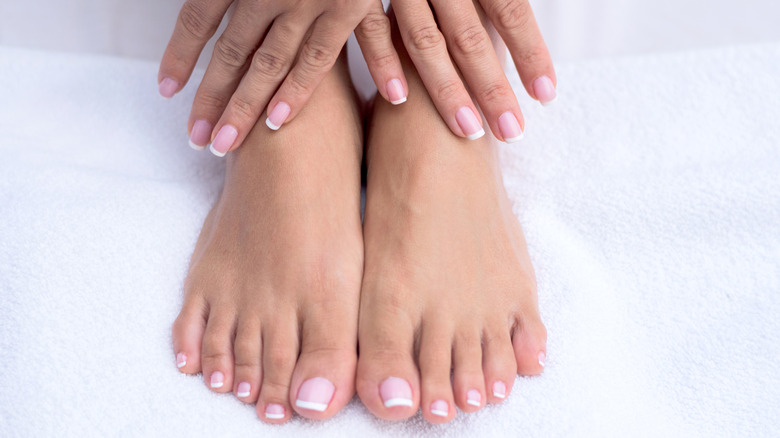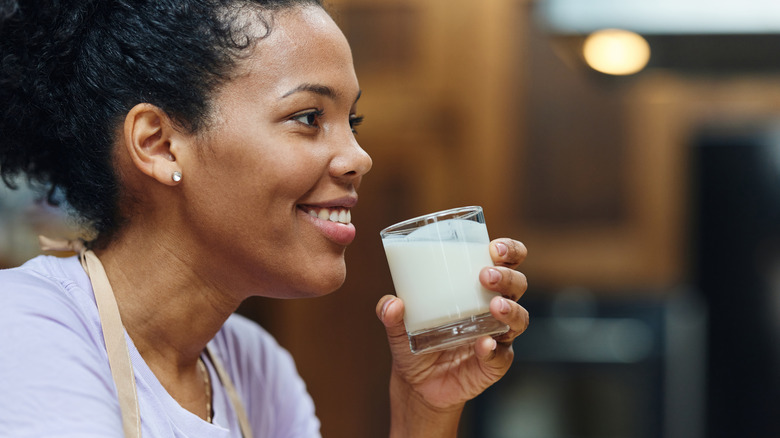What Happens To Your Nails When You Drink Milk Every Day
We drink milk for strong bones and teeth. At least, that's what we were told as kids and often, it's the messaging surrounding dairy that still reaches us as adults. Cow's milk is a great beverage to consume if you're looking to curb your appetite on a weight loss journey too.
Have you ever wondered, however, what regular milk consumption can do for your nails? A lot of the nutrients that milk is known for — namely protein, calcium, and vitamin D — can also benefit your nails. Your body needs calcium to ensure that you don't end up with thin, weak, and brittle nails that break off easily every time there's some type of pressure on them. You need protein to boost the production of keratin — a fibrous structural protein that your nails are mainly made up of. Vitamin D is essential if you want your nails to not peel or crack, per Toronto-based family medicine practitioner Dr. Sheila Wijayasinghe (via Livestrong). Your body also requires vitamin D to ensure adequate and proper absorption of calcium. But when referring to vitamin D, we're mainly talking about fortified milk; the unfortified kind has only negligible amounts of the nutrient.
These aren't the only nail-friendly nutrients in milk.
Other nutrients in milk that support your nail health
There are a few more ingredients in cow's milk that also help your nail health, namely B vitamins, iron, magnesium, and zinc. One cup of whole milk contains 46% of your recommended daily amount (RDA) of vitamin B12, 7% of your RDA of magnesium, 11% of your RDA of zinc, and 0.073 milligrams of iron.
Your nails need vitamin B12 for iron absorption and to keep them strong and healthy. In fact, according to a 2018 study published in BMJ Case Reports, a vitamin B12 deficiency could manifest in bluish discoloration and darkened streaks on your nails.
You need magnesium for protein synthesis and to prevent ridges on your nails. Zinc ensures that your nails keep growing the way they're supposed to. Per a 2013 study published in the International Journal of Trichology, zinc deficiency could lead to a decrease in nail growth rate and fragile and brittle nails. It could also contribute toward the degeneration of your nail bed and white spots on the surface. Your nails need iron for the same reason the rest of your body needs iron — to transport oxygen to where it needs to go. Iron is a key part of red blood cells. If you have anemia (not enough healthy red blood cells), your nails might be concave or have vertical ridges on them.
Cow's milk benefits aside, however, what happens to your body when you drink milk every day? Are there concerns?
Things to consider about cow's milk consumption
It goes without saying that whether or not you're looking for foods you should be eating for stronger nails, cow's milk is not for everyone. Vegans, vegetarians, and those who are lactose intolerant, for example, would get their nail-friendly nutrients from other sources. When it comes to plant-based milks, soy milk can give you a great amount of protein and calcium-fortified unsweetened almond milk could help in the calcium department.
You may want to avoid cow's milk if you have hypothyroidism, skin conditions like acne or eczema, or a milk allergy. Dairy consumption was thought to be a trigger when it came to acne flare-ups, according to a 2016 study published in the Journal of the American Academy of Dermatology, and milk and dairy were on a list of foods that could worsen eczema, per a 2019 study published in the Journal of Microbiology, Immunology, and Infection.
Plus, nail health is about a lot more than just drinking milk. For example, you have to keep them clean, trim them regularly, avoid biting them, and not make the mistake of using them as tools to pry things open. Apart from your diet and general nail habits, your genes and overall health play a part too. While milk happens to be one piece of the puzzle, you're going to have to take a holistic approach when it comes to nail health. Also, see a dermatologist if you notice discoloration, chipping, cracking, or streaks and ridges that look concerning.



